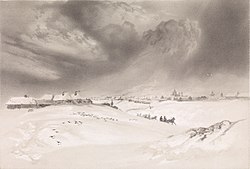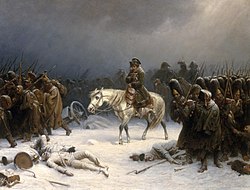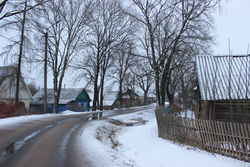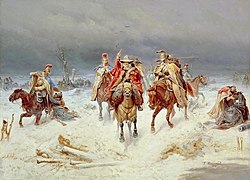Battle of Krasnoi
[15] Throughout the four days of combat, Napoleon attempted to rush his troops, stretched out in a 30 mi (48 km) march, past the parallel-positioned Russian forces along the high road.
Despite the Russian army's superiority in horse and manpower, Kutuzov hesitated to launch a full offensive, according to Mikhail Pokrovsky fearing the risks associated with facing Napoleon head-on.
This strategic decision allowed Napoleon to successfully withdraw Davout and his corps but it also led to his immediate retreat before the Russians could capture Krasny or block his escape route.
Despite fair weather, the three-week march to Smolensk, moving approximately 18 km (11 mi) a day, proved disastrous, subjecting the Grande Armée to challenges like traversing a sparsely populated area with continuous forest, abandoned villages, grappling with demoralization, disciplinary breakdowns, hunger, extensive loss of horses and crucial supplies, as well as persistent harassment from Cossacks and partisans who made it impossible to forage.
[33][d] Having lost contact with Kutuzov over the past two weeks, Napoleon mistakenly assumed that the Russian army had suffered equally due to harsh conditions and was a couple of days behind.
[3] The Russian position at Krasny began forming on 15 November, when the 3,500-strong flying advance guard of Adam Ozharovsky took possession of the town, located in the Pale of Settlement, and destroyed magazines and stock before the French arrived.
[67] Recognizing that Ozharovsky's position was dangerously isolated from Kutuzov's main army, Napoleon dispatched the Young Guard under General Claparède on a surprise attack against the Russian encampment, which was not protected by pickets.
Fyodor Petrovich Uvarov succeeded to cut off Eugène de Beauharnais and his IV corps from the rest of the army but refrained from launching an attack on the rear with his cavalry.
This unexpected attack instilled panic among the French troops, resulting to a hasty retreat from the road and leaving the rear guard (Dutch 33rd Regiment) on the verge of annihilation.
[90] An intriguing, though poorly documented incident occurred near the Losvinka when the rear end of the I Corps baggage train, including Davout's jammed carriages, fell into the hands of the Cossacks.
The retreat was anticipated; it was necessary to get rid of everything that could not be taken along because the number of my horses, already greatly diminished, had suffered further losses by the obligation to complete the teams of the batteries that were going into battle, and it was necessary to sacrifice part of the equipment.
"[96] Before daylight broke, Napoleon prepared his Imperial Guard for a bold feint against Golitsyn, hoping that this unexpected maneuver would dissuade the Russians from launching an assault on Davout.
[97] Napoleon's strategy aimed to delay the Russians long enough to gather the forces of Davout and Ney, allowing the retreat to resume before Kutuzov could launch an attack or attempt to outflank him on the route to Orsha.
As Ségur poetically put it: "Russian battalions and batteries barred the horizon on all three sides – in front, on our right, and behind us"[63] Kutuzov, lacking comprehensive information, reacted hesitantly to Napoleon's presence and audacious maneuver with the Imperial Guard.
[110] Uvarovo, located just a half-hour's walk from Krasny, was initially held by two battalions of Golitsyn's infantry, serving as a fragile forward outpost ahead of the main Russian army.
[87] With precision, the Guardsmen executed an about face and marched back to Krasny, enduring a final devastating barrage of Russian cannon fire as they retreated at 2:00 p.m.[125] The toll was staggering, with only 3,000 survivors remaining from the Young Guard's original 6,000 troops.
[138] According to Dutch officer Van Dedem, a part of the Grande Armee was granted free passage to Orsha,[139] leaving the entire army surprised by the Russians' unexpected complacency.
[u] The pivotal moment was narrated by the English General (in Russian service) Sir Robert Wilson: Forty pieces of cannon loaded with grape, simultaneously on the instant, vomited their flames and poured their deadly shower on the assailants.
The brow and sides of the hill were covered with dead and dying, all the Russian arms were dripping with gore, and the wounded, as they lay bleeding and shivering on the snow, called for "death," as the greatest mercy that could be ministered in their hopeless state.
[162][163][164][165][w] In the ensuing two days, Ney's valiant band defended against Cossack assaults as they traversed 90 km westward along the river, navigating swamps and forests in their search for the French army.
On 20 November, at three in the morning, Ney and Beauharnais were reunited near Orsha, an event that revitalized the demoralized French troops, offering an emotional uplift akin to a triumphant victory.
[6] The Russians captured a significant number of prisoners, including several generals and 300 officers,[174][175][y] while the Grande Armée was forced to abandon most of its remaining artillery and baggage train.
[182]For a couple of days, French soldiers faced dire scarcity of sustenance and endured temperatures ranging from −12 to −25 °C (10 to −13 °F), along with strong winds, an abundance of snow and the discomfort of wet feet during thaw.
[186] Napoleon's reunion with Ney, along with what was left of the III provided a glimmer of hope to rebuild his army around which to rally for the forthcoming Battle of Berezina and the War of the Sixth Coalition.
[187][21]Krasny unquestionably stands as a Russian victory, albeit a notably unsatisfactory one.Tsar Alexander I expressed disappointment in Kutuzov for not completely annihilating the remaining French forces.
"[188][ac] General Robert Wilson, the British liaison officer attached to the Russian Army, documented Kutuzov's late 1812 statement, I prefer giving my enemy a 'pont d'or' [golden bridge], as you call it, to receiving a 'coup de collier' [blow born of desperation]: besides, I will say, as I have told you before, that I am by no means sure that the destruction of Emperor Napoleon and his army would be of such benefit to the world; his succession would not fall to Russia or any other continental power, but to that which commands the sea, and whose domination would then be intolerable.
[189] Wilson strongly accused Kutuzov of deliberately releasing Napoleon from Russia.Louise Fusil, a French singer and actress, who was living in Russia for six years and returned with François Joseph Lefebvre, commanding the Old Guard, wrote: When we came within sight of Krasnoy, the coachman told me that the horses couldn't go any further.
[193] According to Jean-François Boulart: A young woman, a fugitive from Moscow, well-dressed and looking interesting, had just emerged from that brawl, riding on a donkey and struggling with her rather uncooperative mount when a cannonball shattered the poor animal's jaw.
[95]The French surgeon Dominique Jean Larrey wrote: It was a matter of urgent necessity that the army should resume its march after the battle, in order to avoid a new attack, and reach, as speedily as possible, those parts that were inhabited and provided with store-houses.
Throughout the novel, but particularly in this section, Tolstoy defends Kutuzov's actions, arguing that he was less interested in the glory of routing Napoleon than in saving Russian soldiers and allowing the French to continue destroying themselves with a swift retreat.




































